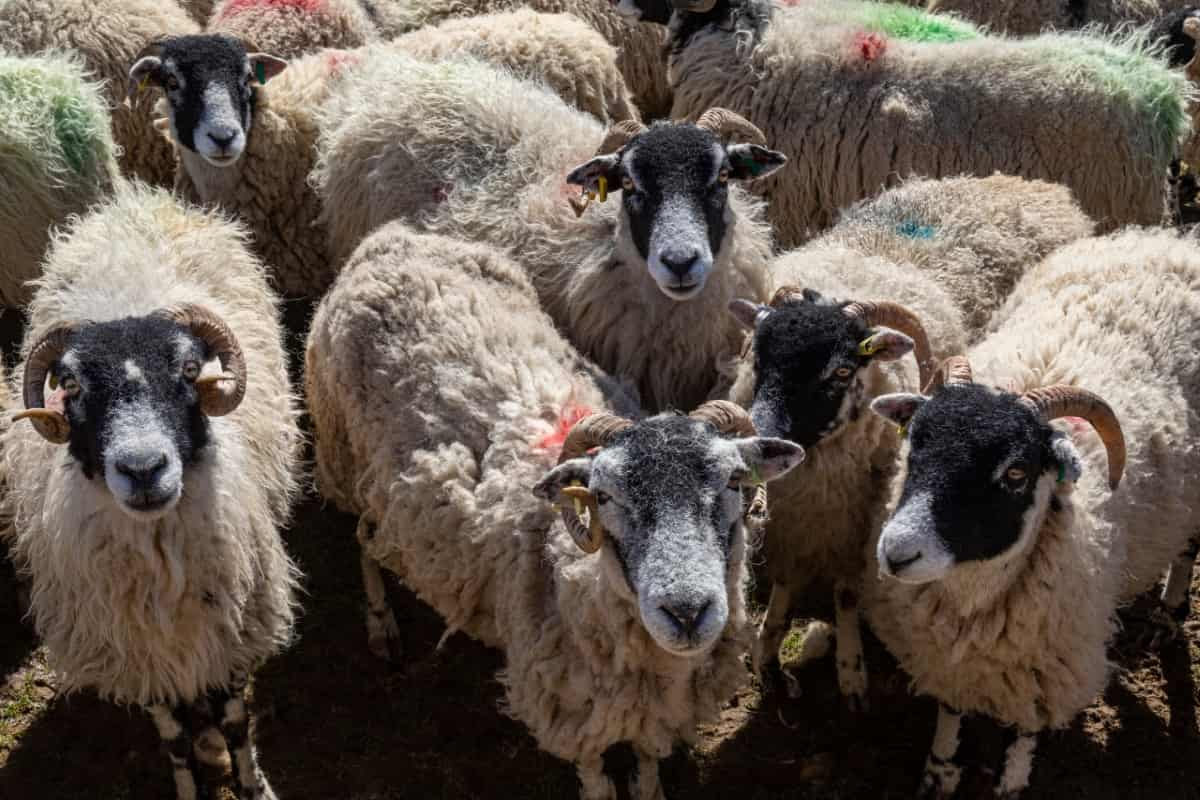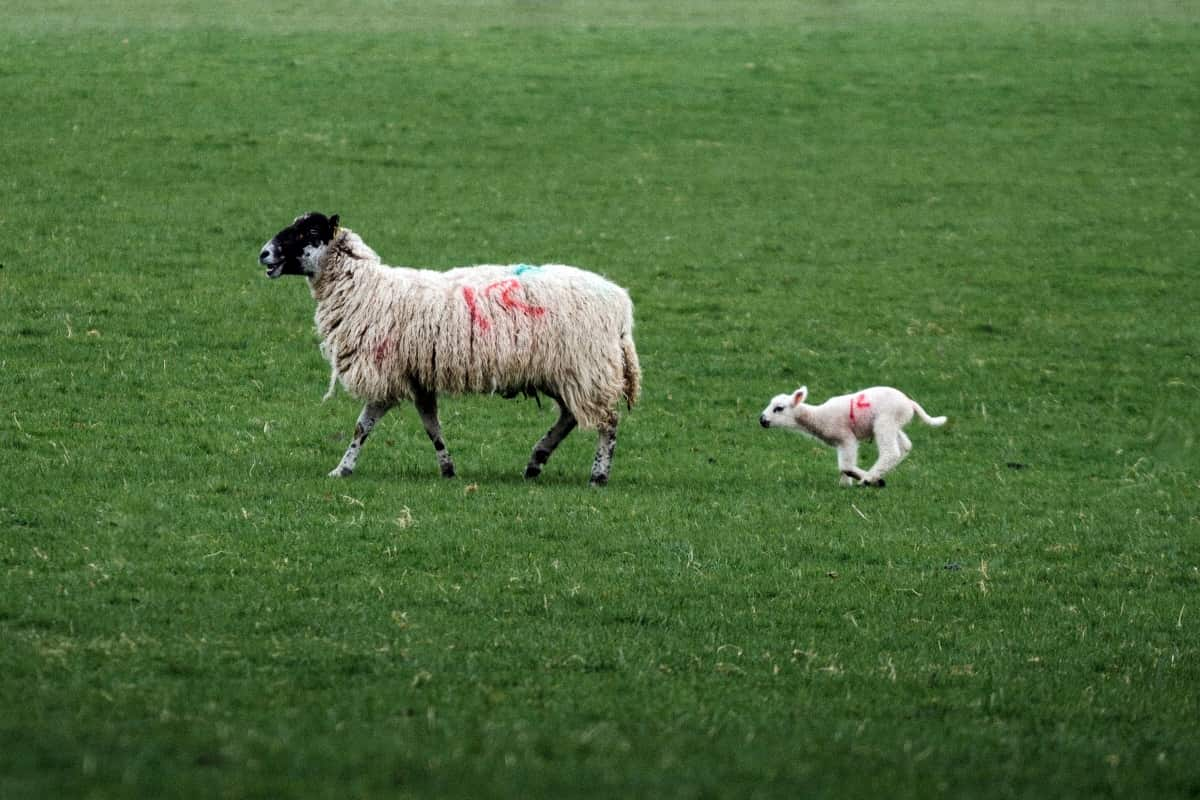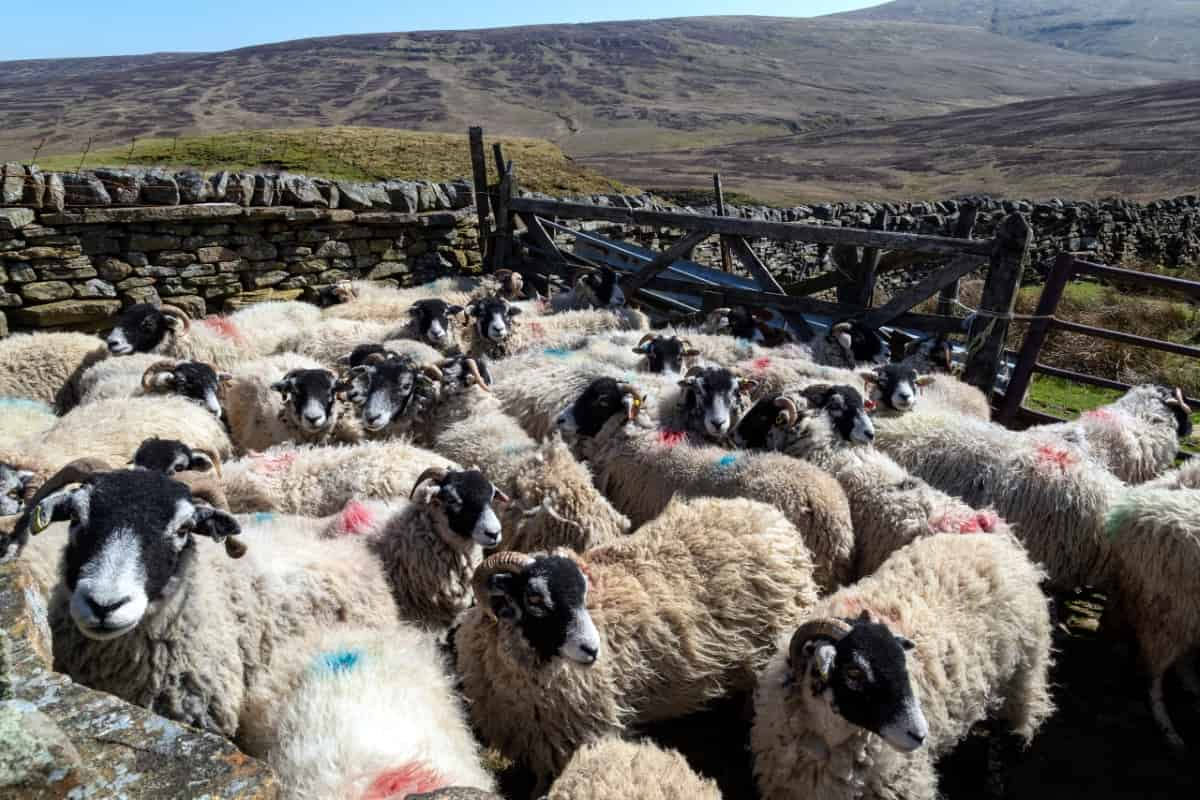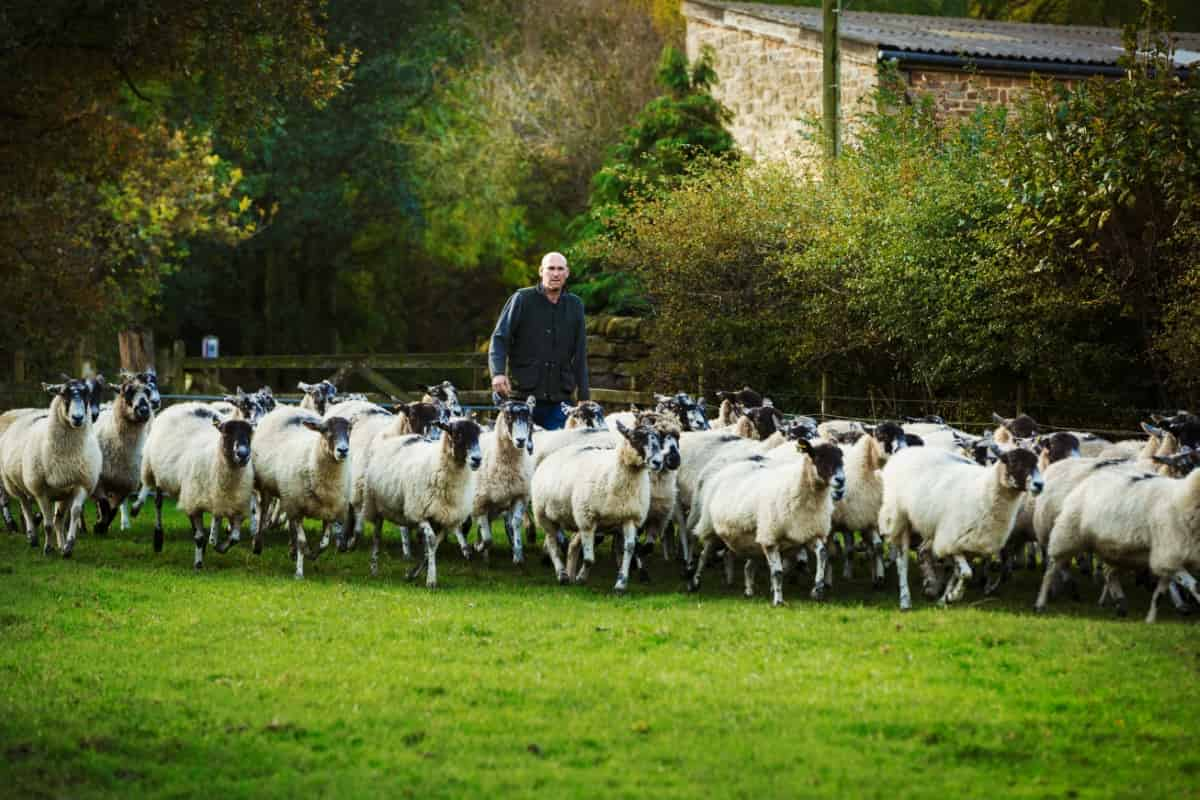Swaledale sheep, originating from the rugged terrain of Northern England’s Swaledale Valley, boast a rich history dating back centuries. Developed by local farmers seeking resilient livestock, these sheep have thrived in harsh environments, shaping their robust characteristics. Bred by local farmers for their resilience and hardiness, Swaledales played a crucial role in sustaining livelihoods in challenging terrains.
Notable Characteristics and Adaptability Swaledale Sheep
- Recognizable by their white faces, thick woolly coats, and curled horns.
- Thrive in harsh upland environments, displaying exceptional foraging abilities.
- The average live body weight of the mature Swaledale sheep is around 90-100 kg.
- They are known for their ability to withstand inclement weather and sparse grazing conditions.
- Beyond their historical role, Swaledales continue to be valued for their versatile wool and flavorful meat, contributing to sustainable agricultural practices.

Guide to Raising Swaledale Sheep
Selecting Your Swaledale Sheep
Choosing Healthy Breeding Stock
Ensure robust physical health in Swaledale sheep by checking for signs of diseases, parasites, or abnormalities. Select Swaledale sheep breeding stock with a clean bill of health to safeguard the overall flock’s well-being.
Evaluating Ewes and Rams for Quality
Opt for individuals with well-proportioned bodies, strong legs, and sound feet, as these traits contribute to their overall vitality and longevity. Prioritize breeding stock with a proven record of fertility and successful reproduction. Consider the genetic traits of Swaledale sheep, aiming for individuals with desirable traits such as strong wool quality, good mothering instincts, and adaptability to local environmental conditions.
Housing and Shelter for Swaledale Sheep
Designing an Ideal Sheep Shelter
- Space per Sheep: For Swaledale sheep housing, provide a minimum of 15-20 square feet per sheep to allow for movement and comfort.
- Materials: Construct the shelter with sturdy materials like wood or metal, ensuring durability against harsh weather conditions.
- Security: Install strong fencing to protect against predators and provide a secure environment.
Ensuring Comfort and Safety
- Ventilation: Ensure proper ventilation to prevent respiratory issues and maintain air quality.
- Insulation: Use insulation materials to regulate temperature, keeping the shelter cool in summer and warm in winter.
- Bedding: Provide clean and dry bedding, such as straw or wood shavings, for comfort and hygiene.
- Lighting: Ensure sufficient natural and artificial lighting for the well-being of the sheep.
Swaledale Sheep Nutrition and Feeding
Nutritional Needs of Swaledale Sheep
Swaledale sheep require a balanced diet rich in fiber, protein, vitamins, and minerals to support their health and productivity. Their forage-based diet should include grass, legumes, and roughage to meet their dietary requirements. During winter, when forage quality decreases, supplementing with hay or silage can ensure adequate nutrition. In contrast, during the lush grazing season, monitoring intake to prevent overconsumption and potential health issues is crucial.
Seasonal Diet Adjustments and Supplements
Based on the nutritional requirements of the flock and the quality of available forage, supplements such as mineral blocks or vitamin injections may be necessary to maintain optimal health and performance. Consultation with a veterinarian or nutritionist can help determine appropriate supplementation strategies.
Healthcare and Disease Management
Common Health Issues in Swaledale Sheep
Swaledale sheep, like all livestock, are susceptible to various health issues. Common concerns include parasitic infections such as gastrointestinal nematodes, particularly during periods of grazing. Pneumonia and foot rot are also prevalent, especially in crowded or damp environments. Maintaining proper nutrition and hygiene for proper Swaledale Sheep health management.
Vaccination and Routine Health Care
Routine vaccinations are essential for preventing diseases such as clostridial infections and lamb dysentery. Regular health checks should include monitoring for signs of illness or distress, ensuring proper nutrition, and providing access to clean water and shelter. Timely interventions, including deworming and foot trimming, can significantly enhance the overall health and welfare of Swaledale sheep.
In case you missed it: Sheep Breeding Calendar and Sheep Gestation Stages

Breeding and Lambing Season
Successful Breeding Practices
Ensure successful reproduction with strategic breeding practices, optimizing ewe and ram selection based on health and genetics. Implement synchronized breeding, monitor ewe body condition, and address nutritional needs for optimal fertility. Provide regular health checks and vaccinations for lambing season Swaledale sheep.
Preparing for and Managing Lambing
Create a comfortable lambing environment, providing adequate shelter and nutrition. Develop a lambing management plan, including emergency protocols, and closely monitor ewes during the lambing process.
Wool Production in Swaledales and Shearing
Swaledale Wool: Characteristics and Uses
Swaledale wool is coarse and dense, with a natural resistance to water, making it ideal for outdoor wear. Swaledale wool is commonly used in the production of carpets, rugs, and outerwear garments. Its robustness makes it particularly suitable for rugged outdoor clothing and accessories.
Shearing Techniques and Timing
Shearing of Swaledale sheep typically occurs once a year, usually in the spring, before warmer weather sets in. Shearers use traditional hand shears or mechanical clippers to remove the wool in a process that requires skill and care to ensure the sheep’s welfare and the quality of the fleece.
Flock Management Swaledale
Ensuring the Well-Being of Your Flock
- Healthcare: Regular veterinary check-ups, vaccinations, and parasite control are essential.
- Nutrition: Provide a balanced diet with adequate forage and supplements as needed.
- Shelter: Ensure access to shelter from harsh weather conditions to prevent stress and illness.
Record-Keeping for Productivity
- Medical Records: Maintain detailed records of vaccinations, treatments, and health issues.
- Breeding Records: Track breeding dates, lambing, and genetic information to optimize breeding programs.
- Production Data: Record lambing rates, growth rates, and wool production to monitor flock performance.
Marketing Swaledale Products
Selling Swaledale Sheep, Wool, and By-Products
- Focus on eco-conscious consumers, textile artisans, and small-scale farmers seeking heritage breeds.
- Highlight Swaledale sheep’s hardiness, premium wool quality, and versatility in various products.
Identifying Market Opportunities
Establish an engaging website and active social media presence to showcase Swaledale products. Utilize platforms like Instagram, Pinterest, and Etsy to reach a broader audience. Explore opportunities to penetrate new markets, such as outdoor enthusiasts, interior designers, and specialty retailers, through targeted marketing campaigns and product placements.
In case you missed it: Blackhead Persian Sheep: Characteristics, Origin, Uses, Breeding, Lifespan, Price, and Size

Swaledale Sheep Farming Sustainability
Sustainable Practices for Swaledale Sheep Farming
- Pasture Management: Rotational grazing to maintain pasture health and prevent overgrazing.
- Natural Breeding Methods: Prioritizing natural mating to maintain genetic diversity and avoid reliance on artificial insemination.
- Minimal Chemical Inputs: Limiting the use of chemicals such as pesticides and fertilizers to preserve soil and water quality.
- Local Feed Sourcing: Supporting local agriculture by sourcing feed from nearby farms to reduce transportation emissions.
- Low-Impact Husbandry: Employing low-stress handling techniques and minimal intervention birthing practices to ensure animal welfare.
Conservation and Preservation Efforts
- Habitat Restoration: Collaborating with conservation organizations to restore and protect natural habitats crucial for Swaledale sheep.
- Genetic Preservation: Participating in breeding programs aimed at conserving rare and heritage breeds.
- Community Engagement: Educating the community on the importance of Swaledale sheep in maintaining biodiversity and cultural heritage.
- Land Stewardship: Implementing land management practices that promote biodiversity and ecosystem health.
In case you missed it: Ultimate Guide to Small Sheep Barn: Design, Layout, Plans, Cost, and Ideas

Conclusion
Raising Swaledale sheep can be a rewarding and fulfilling endeavor for farmers of all experience levels. By following the Swaledale Sheep care tips and strategies outlined in the guide, you can ensure the health and well-being of your flock while maximizing productivity and profitability on your farm.
- Feed Your Flock for Less: Top 10 Tips to Save on Chicken Feed
- Ultimate Guide to Ossabaw Island Hog: Breeding, Raising, Diet, and Care
- Hatching Answers: The Top 10 Reasons Your Chickens Aren’t Laying Eggs
- Eggs and Economics: Breaking Down the Cost of Raising Backyard Chickens
- Defend Your Greens: Proven Methods to Keep Iguanas Out of Your Garden
- Ultimate Guide to Cinnamon Queen Chicken: A Comprehensive Guide for Beginners
- Ultimate Guide to California Tan Chicken: Breeding, Raising, Diet, Egg-Production and Care
- Ultimate Guide to Marsh Daisy Chicken: Breeding, Raising, Diet, and Care
- 10 Types of Chicken Farming Businesses You Can Start for Profits